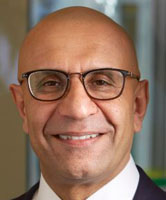4 Challenges To Overcome In Rare Disease Trials

By Ed Miseta, Chief Editor, Clinical Leader

Albireo Pharma is a clinical-stage biopharmaceutical company that was launched in 2008 in Sweden when AstraZeneca decided to exit the early gastrointestinal therapeutic space. Scientists from AstraZeneca, with expertise in bile acids and bile acid modulators, took the company’s more promising assets and formed the new company.
One of those assets, now called A4250, is a novel bile acid modulator that has been in development for rare cholestatic liver diseases. It is a selective inhibitor of the ileal bile acid transporter (IBAT). The product, which acts locally in the gut, can effectively drain excess bile acids that get stuck in a patient’s liver.
“A4250 is being developed for multiple pediatric cholestatic liver diseases,” says Ron Cooper, president and CEO of Albireo. “It is currently in a Phase 3 study to treat progressive familial intrahepatic cholestasis (PFIC) and topline results are expected by the end of 2019 or early 2020. We believe A4250 has the potential to become the first approved pharmacologic treatment for PFIC, and then expand into other pediatric cholestatic liver diseases.”
A Pediatric Population

“These children have terrible pruritus, an itching condition sometimes so severe that they scratch off their skin,” says Cooper. “The diagnosis is usually made in year one or two, and the symptoms are severe pruritus, an inability to sleep, and a failure to grow and thrive. Although the disease can be easily diagnosed from symptoms, it is usually confirmed through genetic testing.”
Still, the diagnosis brings no relief to the children or their parents. There is no approved drug, and the current treatment option for symptoms of severe itching are adult drugs that has not been tested in children. The treatment will not always work, and even if it does, the benefits do not last long. This is due to the progressive nature of the disease.
Unfortunately, parents are faced with two options: a liver transplant or a surgery called partial external biliary diversion that drains excess bile acids from the patient into an external stoma bag. Both options are extreme for any child.
Four Clinical Challenges
In conducting trials with pediatric patients in this space, Albireo faces four challenges common to developers of pediatric rare disease drugs. The first is the lack of a natural history of the disease. The second is determining the study design and appropriate endpoints for the trial. The next is determining the correct dosage form for these pediatric patients. The final challenge is patient recruitment.
The lack of a natural history is often a challenge for those working on rare and ultra-rare diseases. There is often no published literature on the disease or its prevalence, and there are usually no patient registries. If researchers do not know the natural history of the disease, there is no way to know what type of intervention is required.
“Deciding how to address the natural history of the disease is something we spend a lot of time discussing,” states Cooper. “We work with key opinion leaders discussing current literature and trying to understand the disease progression. We commissioned an academic group and provided them with an independent grant to work on a natural history. They have created a retrospective review and are creating the world’s largest database of longitudinal information on PFIC patients. The database currently has close to 600 patients.”
Select The Right Endpoints
Selecting the appropriate endpoints for some studies is not difficult. For cholesterol, diabetes, or hypertension, for example, the FDA has guidance in place for sponsors. Generally, a meeting with the agency is not even necessary. The endpoints might specify that the sponsor show a difference in some level, such as LDL (low-density lipoprotein) for a cholesterol drug trial.
Unfortunately, that situation does not exist for many orphan diseases, since the natural history is not understood. “We have to meet with the regulatory agencies,” says Cooper. “When we do, determining the correct endpoints is a real challenge. We are basically starting out with a blank piece of paper, figuring out endpoints that make sense for the patient and the study. For A4250, we ended up with different primary endpoints for the U.S. and Europe. This is something that can happen when dealing with an ultra-rare disease indication.”
Having to do two studies within an orphan population would obviously be a challenge. However, Albireo was able to get the FDA and EMA to agree that one study would be sufficient for approval. There would simply be different primary endpoints for the different sites. For the EMA, reduction in serum bile acids would be the primary endpoint. For the FDA, it would be reduction in pruritus. In order to measure the pruritus, which cannot be done by blood draw, Albireo also had to create a proprietary measurement tool.
Find The Appropriate Dosage Form
The patient population for A4250’s lead indication, PFIC, is children. That means the dosage form also becomes a challenge. The company had to consider factors such as getting children to ingest the treatment, the taste and consistency of the medicine, and how the dosage form might impact adherence.
For the Phase 2 study, Albireo was able to develop a dosage form that was tiny sprinkles. The same dosage form will be used in the Phase 3 trial. Patients receive a large capsule which is intended to be opened. The contents can then be sprinkled in a child’s food. Older children have the option of swallowing the entire capsule.
In any ultra-rare disease trial, patient recruitment is a concern. With only 8,000 to 10,000 PFIC patients in the U.S. and EU, locating participants for a trial is difficult. There are several steps Cooper recommends taking to overcome this challenge.
First, he advises to retain your CRO partner very early on in the process. Site feasibility is performed with the CRO to determine the number of sites that would be necessary to execute a global trial. For a study with 60 patients, the company had to engage with 35 to 45 sites. “That is literally one and a half patients per site,” says Cooper. “And the patients are in the U.S., Europe, Canada, Australia, and the Middle East.”
Albireo had its CRO in place even before going to the FDA or EMA to discuss the trial design. This enabled the company to get a better idea of how many patients had the disease. Albireo opted to partner with a leading CRO that worked in the orphan disease space.
“We went through a very careful bidding and vetting process to find the right CRO,” says Cooper. “We felt our partner would have to have the right capabilities and capacities to execute this study. We picked a global CRO that has extensive expertise in the orphan space, and that we felt could execute the trial in the time frame we proposed.”
Interact With Key Opinion Leaders
Cooper also recommends working closely with key opinion leaders in the field. In the case of PFIC, that means engaging with pediatric hepatologists. Interacting with these individuals helped Albireo determine how many sites would be necessary for the trial and gain insight into how these physicians work with patients.
Finally, Cooper stresses the importance of working with patient groups. Unfortunately, in the rare disease space, some patient groups are not always well-developed, but he believes the rise of the social media technology to help connect groups and patients is important in amplifying awareness around clinical trials.
“We spent at least two years speaking with key opinion leaders, parents, patient groups, and payers to be sure we were designing the right trial,” states Cooper. “A lot of that input helped us when we were designing the pruritus tool. We performed some very sophisticated research with the children and their parents to gather as much input as possible. There was a tremendous amount of dialogue with all those stakeholders before we landed on the final protocol.”
Consider The Needs Of Patients
Finally, Cooper is a firm believer in making trials patient-centric. This is especially vital when your patients are children and can be located around the world. That situation is complicated by the fact that most trial sites are situated in major metropolitan areas, which may not be true of patients. To facilitate travel to sites, Albireo engaged a concierge service.
“The parents of these children are often young, too,” says Cooper. “From an economic perspective, having to pay for travel costs out-of-pocket can be very difficult. The concierge service takes care of their travel arrangements. If they need a hotel room or food, all of it is paid for. The parents do not have to pay anything out of pocket.”
Cooper believes the Orphan Drug Act of 1983 has been a game changer for rare disease companies. He believes it has been transformational in accelerating the development and approval of new medicines. The decade before the Act, around a dozen new treatments were approved. In 2017, 80 new drugs for orphan designations were approved. He hopes the 21st Century Cures Act will continue this trend.
“We have still only begun to scratch the surface,” he adds. “Today there are 7,000 rare diseases affecting 25 million to 30 million people. We only have treatments for five percent of them. There is still a lot of work that must be done.”
